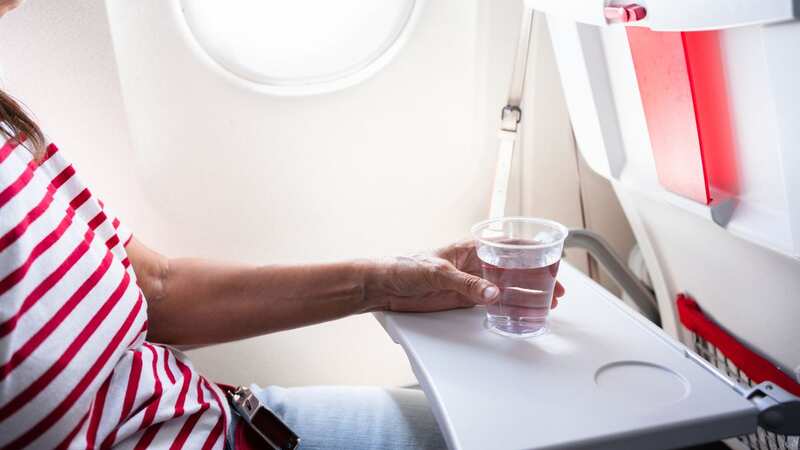Travel expert warns passengers to stop touching dirtiest part of the plane
A travel company has highlighted the ickiest, most perturbing parts of a plane that germaphobes may want to avoid.
Travel tour operator Ski Vertigo has shared the top ten germ hotspots on planes. If you are not a fan of coming into contact with germs or simply feel like knowledge is power, then be mindful of these high-grime areas.
One of the dirtiest surfaces is unfortunately one you're likely going to touch during your flight - the tray tables. The team warned: "These surfaces see a variety of uses during flights, from food consumption to being a resting spot for personal items and electronic devices.
"Given their multifunctional use and the fact that cleaning crews often have limited time between flights, tray tables may not receive a thorough cleaning, leading to a significant build-up of bacteria and viruses. This makes them a prime location for the transmission of illnesses."
They're not the only surface to avoid though - check out the full list below.
 Brit uses browser hack to bag business class seat for less than price of economy
Brit uses browser hack to bag business class seat for less than price of economy
 Plane tray tables are a muck magnet (Getty Images)
Plane tray tables are a muck magnet (Getty Images)Bathrooms: Given the small space and the high number of users, aeroplane bathrooms are a hotspot for germs. The flush button, door lock, and faucet handles are touched by nearly every user, often without proper handwashing, making these surfaces a breeding ground for pathogens.
Seat back pockets: These pockets are meant for storing items such as books, electronics, and travel essentials but often end up holding trash, used tissues, and food wrappers, which can contribute to the growth of bacteria. The cleaning of these pockets is not always thorough, leading to the accumulation of germs over time.
Window shades: Many passengers adjust the window shades throughout a flight, but these are not typically a focus during cleaning. This frequent contact by hands, which may not always be clean, allows for the transmission of germs to and from the shades.
Pillows and blankets: When airlines do not provide pillows and blankets in sealed packaging, there's a risk they've been used by previous passengers without being properly cleaned. This can lead to the spread of skin cells, oils, and potentially infectious agents.
Lavatory handles: Every person who uses the lavatory touches the toilet and door handles, making them high-contact points for germs. These handles are a critical area for the transmission of bacteria and viruses, particularly if handwashing is not thorough.
Seat-back areas: This includes the seat-back screens, tray tables, and pockets. The high level of activity in these areas, combined with insufficient cleaning between flights, means they can harbour a wide range of germs.
Seats and seatbelts: Used by different passengers every day, these areas may not receive the level of cleaning required to eliminate germs between flights, making them potential vectors for disease transmission.
Air vents and overhead bin handles: Frequently touched by passengers looking to adjust air flow or access their belongings, these surfaces are often overlooked during cleaning processes. The repeated contact facilitates the spread of germs.
Headrests: Direct contact with passengers' heads and hair means headrests can accumulate oils, sweat, and potentially infectious particles. Without regular and thorough cleaning, headrests can contribute to the spread of germs.
A flight attendant, who spoke to Ski Vertigo, offered their tips for minimising germ contact on a plane. They said: "Awareness and preparation are your best allies against germs on a plane. Beyond the basic measures, consider the timing of your bathroom visits; early in the flight or right after cleaning, when fewer germs are present, can make a significant difference.
 Flight attendant always 'throws a bottle under the hotel room bed' to stay safe
Flight attendant always 'throws a bottle under the hotel room bed' to stay safe
"If you must use the seat-back pocket, consider lining it with a disposable bag for your items. This not only keeps your belongings clean but also simplifies cleanup and minimises your contact with potential contaminants. Remember, the goal isn't to live in fear of germs but to smartly mitigate risks so you can enjoy your travels to the fullest.
"For longer flights, consider packing a small 'hygiene kit' that includes face masks, hand sanitiser, disinfectant wipes, and even a spare set of clothes in your carry-on. Changing clothes after a long flight can help you feel refreshed and reduce the likelihood of transferring germs from the plane to your final destination.
"By implementing and understanding these health measures, you can turn your flying experience into a journey that prioritises well-being instead of being exposed to an environment that is full of germs.”
Check out by signing up to our free weekly newsletter.
Read more similar news:
Comments:
comments powered by Disqus


































